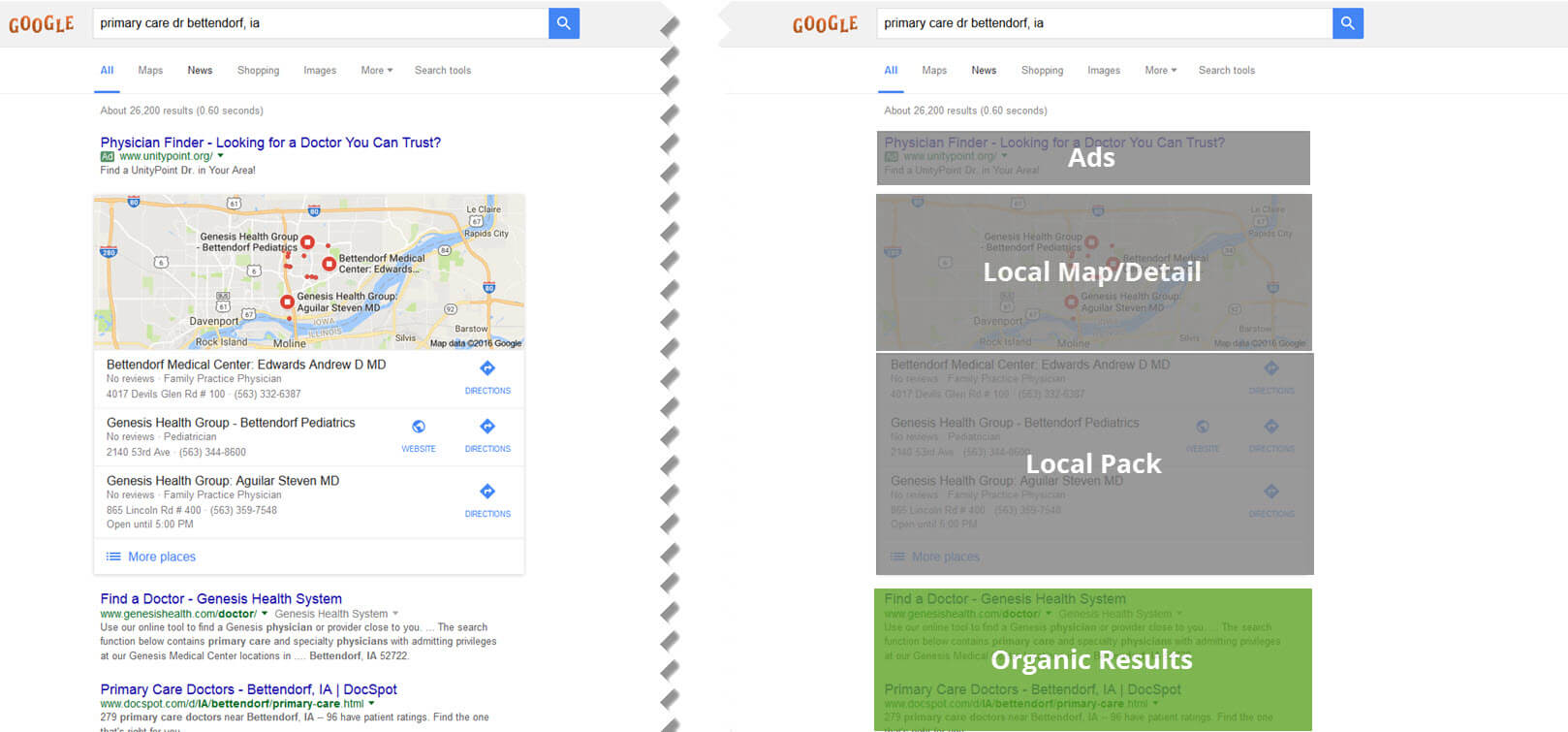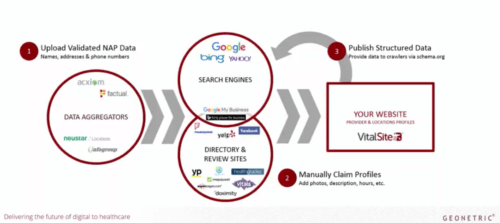According to Google, more searches take place on smartphones than computers – and combine that stat with the fact mobile users expect information returned or presented to be localized. Mobile users also expect the information returned to be accurate. But that’s not always the case – which frustrates searchers and healthcare marketers alike.
It’s time for you to take control of your local listings and get on the path to optimizing your organization for local search. We’re here to help show you how.
The changing search landscape
Before showing you how to improve local search optimization, it might be helpful to understand what exactly is changing in the SEO landscape. There’s really two main shifts we’re seeing that are requiring everyone to rethink search.
- Organic space is disappearing
You may have noticed that the big trend within search engine results pages (SERP) lately is diminishing space for organic results. What used to have ample room is now given just two or three results. The page is instead filled with address and map information as well as what is known as the “local pack” – search results you see in a query that has local intent.
The key to having a valuable presence in this new SERP? When you think about optimizing for search, you must start thinking beyond just the URLs on your website.
- Search is more than web browsers
Another important shift in the landscape revolves around the fact that search is moving beyond web browsers. Think Siri, Cortana and other voice-activated search engines. These types of search platforms retrieve data in different ways than traditional search, and rely much more heavily on structured data – which we’ll get to in a moment.
Validating, claiming and structuring
Now that you understand what’s impacting some of the changes in the search world, let’s talk about how to optimize your hospital and clinics more effectively and position your organization for local search success.
There are a lot of moving pieces when it comes to determining what will show up in a SERP. But there is a rhythm to the madness. Here’s the map we use to shed light on the local search world.

As you can see, there are many factors that impact local search results. Some are more traditional – like page titles and descriptions – but others aren’t as familiar, including data aggregators and directory/review sites like Vitals.
Let’s look at how you can impact this ecosystem and hopefully improve the accuracy and position of your local search listings.
- Validate name, address, phone (NAP) data
Search engines like Google and Bing rely on data aggregators to provide reliable information. As described by MOZ, there are four primary sources of data that filter into the major search engines. And of course other companies like yellowpages.com also play a role in sending search engines information, so the landscape quickly gets crowded. Unfortunately many healthcare marketers are realizing their business information is incorrect in Google – and thus most likely incorrect in the aggregators. It’s critical to make sure the NAP information published about your hospitals, clinics and other facilities is accurate. Unfortunately, figuring out how to change your business information is more complicated than it should be – but it’s important you set aside some time to figure it out if you want to improve your local search rankings. (Of course, we’re happy to help if you get frustrated.)
- Claim your listings
The data from the aggregators filter into both the directory and review sites (like Healthgrades, Vitals and Doximity, to name a few) as well as directly into the search engines. Today this area sees a lot of overlap, especially as Google and Bing both have moved more into the directory side of things with Google My Business and Bing Places. Although there are a number of directory and review sites, it’s important to go through the list and manually claim your profiles. This allows you to build out those profiles with more information than what the aggregators provide – you can add information like facility photos, descriptions and clinic hours.
- Publish structured data
The third piece of the puzzle has to do with publishing structured data on your website. Using schema.org markup, you can help tell the web crawlers from the search engines important details about your pages. If you’ve been putting off investing in schema.org markup, the time is now. For the last few years Google has been investing more and more in semantic search, and as search moves into new areas like local and voice-activation, using schema.org markup will become more and more important. Search engines have demonstrated schema.org helps them improve the accuracy of results, especially as they move to understanding searchers’ intent and contextual meaning, not just the string of keywords typed in a browser. Schema.org discussions get pretty advanced pretty quickly, but if you’re looking to get started check out our blog post Four Essential Tools for Getting Started with Schema.org Markup.
It’s time to invest in local search optimization
The bottom line – if you’re ready to invest in optimizing for local search it’s going to take some time and resources to do it right. But you have to. Right now, 50% of your health consumers are looking for local results on mobile and that percentage is only going to grow.
Feeling overwhelmed or confused? No worries. We help hospitals and health systems around the country implement effective local optimization strategies and we’d be happy to help you too. Contact us today and let’s get started.


